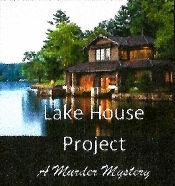FEAR THE HYPHENATE
If a person is lucky enough, they will discover their passion in life and be able to fine tune and truly excel at that skill. Others flounder about, trying a bit if this and a bit of that, becoming a jack of all trades but master of none. They’re called “hyphenates.” In the entertainment industry, carving out a career in any single arena, let alone succeed in multi-platforms, is challenging. In film, Woody Allen is that rare hyphenate: a multi-talented writer-director-actor. In theater, the “triple threat” hyphenate is an actor-singer-dancer.
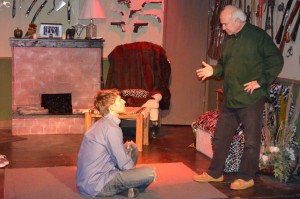 As the number of hyphens increases, so does the likelihood of absolute failure on all fronts. Case in point: The Lake House Project, the first installment of The Lake House Chronicles trilogy currently playing at the Hudson Guild Theatre in Hollywood. Randall Gray is the writer-director-set designer-lighting designer-sound designer-photographer. Unfortunately, he doesn’t seem to show an affinity for any of them. It’s been years since I have sat through such an inept and misguided theatrical effort.
As the number of hyphens increases, so does the likelihood of absolute failure on all fronts. Case in point: The Lake House Project, the first installment of The Lake House Chronicles trilogy currently playing at the Hudson Guild Theatre in Hollywood. Randall Gray is the writer-director-set designer-lighting designer-sound designer-photographer. Unfortunately, he doesn’t seem to show an affinity for any of them. It’s been years since I have sat through such an inept and misguided theatrical effort.
Let’s examine how Mr. Gray’s hyphenations all went so terribly wrong.
The writer: The story concerns Byron Meade (Jay Antonos), a successful writer whose financial woes are exposed to the media by his accountant, Christopher Devlin (Robert Sherry). Meade cooks up a plan with his assistant, Joshua Townsend (Jesse Welch), to get revenge on the number cruncher. It’s supposed to be a 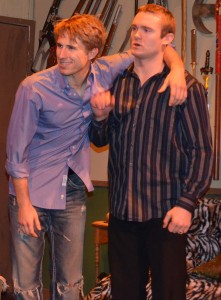 mystery, but there is no sense of danger or intrigue. Get me a Thesaurus, because “vapid,” “inane” and “insipid” are just a few of the words to describe the dialogue, replete as it is with ill-fitting descriptive grammar. It’s a ridiculous rendition of a promising idea (and to think there’s two more installments to not look forward to).
mystery, but there is no sense of danger or intrigue. Get me a Thesaurus, because “vapid,” “inane” and “insipid” are just a few of the words to describe the dialogue, replete as it is with ill-fitting descriptive grammar. It’s a ridiculous rendition of a promising idea (and to think there’s two more installments to not look forward to).
The sound design: We are at a lake house (obviously, considering the title); setting the mood is a single cricket—an incessant, overly loud, completely annoying chirping that had me twitching after fifteen minutes. In addition, every action on stage is accentuated with an array of music reminiscent of 1950’s horror movies. The problem is that there is absolutely nothing spooky or scary going on, rendering the way-too-loud music utterly inappropriate. Then Act II opens with a roaring thunder storm that sounds as if it had been recorded in a video arcade. If a cacophonous mess was the goal, consider it achieved.
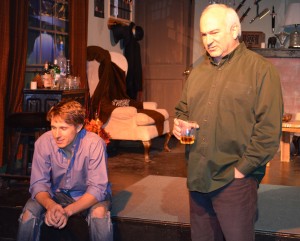 The lighting design: The fireplace has a string of small intermittingly glowing purple lights pasted on or poking through a black background; several battery operated faux candles are perpetually lit even in the blackouts (which for some unknown reason feature bizarre disco-esque gobo effects); and the lightning effects spark with all the intensity of a disposable lighter. Other than that the lights are either on or off.
The lighting design: The fireplace has a string of small intermittingly glowing purple lights pasted on or poking through a black background; several battery operated faux candles are perpetually lit even in the blackouts (which for some unknown reason feature bizarre disco-esque gobo effects); and the lightning effects spark with all the intensity of a disposable lighter. Other than that the lights are either on or off.
The set design: Many of the poorly constructed, amazingly amateurish and crooked pieces appear to have been made out of old refrigerator boxes. Every inch of wall space is covered with various weapons in no discernable pattern; its overkill. And don’t get me started on the fireplace logs which look like the rolled-up newspaper you use to whack your dog after he pees on the floor.
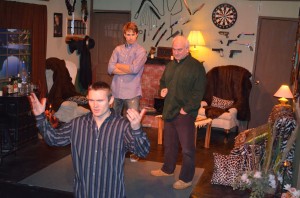 The director: Saving the worst hyphen for last, the clueless Mr. Gray delivers senselessly motivated action and wooden staging, ensuring that his players don’t have a whit of sincere or realistic reactions. A multitude of bizarre choices steadily kept me in dizzying disbelief, but the decision to have actors break the fourth wall was the most vertiginous of all: First, Joshua converses directly to a female audience member, and then Byron bounds off the stage, coming up the aisle to interact with patrons. For the life of me, I could not figure out why anyone who has ever had anything to do with the theater would think this was a good idea. It adds nothing to the show, serves no purpose, and comes completely out of left field. At the curtain call, Gray has the cast leap off the stage to shake our hands and thank us for coming.
The director: Saving the worst hyphen for last, the clueless Mr. Gray delivers senselessly motivated action and wooden staging, ensuring that his players don’t have a whit of sincere or realistic reactions. A multitude of bizarre choices steadily kept me in dizzying disbelief, but the decision to have actors break the fourth wall was the most vertiginous of all: First, Joshua converses directly to a female audience member, and then Byron bounds off the stage, coming up the aisle to interact with patrons. For the life of me, I could not figure out why anyone who has ever had anything to do with the theater would think this was a good idea. It adds nothing to the show, serves no purpose, and comes completely out of left field. At the curtain call, Gray has the cast leap off the stage to shake our hands and thank us for coming.
The production photos: As you can see, they are blurry, poorly lit, and some of the actors have red-eye, matching the orbs in my head after watching this show.
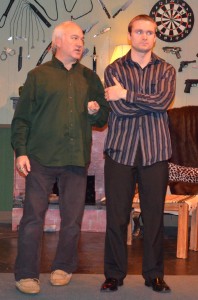 I actually felt bad for the actors, wondering if they had any notion what a bomb they were in. Mr. Welch and Mr. Devlin emit an inkling of talent, but how can they prove it with the odds stacked against them? On the other hand, Mr. Antonos, whose bio bills him as a commercial actor, might be successful at maintaining interest in 30-second snippets, but in a full-fledged production he has zero command of the stage and is a real chore to observe.
I actually felt bad for the actors, wondering if they had any notion what a bomb they were in. Mr. Welch and Mr. Devlin emit an inkling of talent, but how can they prove it with the odds stacked against them? On the other hand, Mr. Antonos, whose bio bills him as a commercial actor, might be successful at maintaining interest in 30-second snippets, but in a full-fledged production he has zero command of the stage and is a real chore to observe.
Lily Tomlin has a joke that goes something like this: The thing that worries me about the man who invented Muzak is: What’s he thinking of next? For me, the same holds true for Mr. Gray, whose cheerleading opening speech was so filled with hype about the possibility of his trilogy becoming a movie that “press rep” could be added to his list of hyphenates. Theatergoers now and in the future have been warned.
photos by Randall Gray
The Lake House Project
Stages Of Gray Theatre Company
Hudson Guild Theatre, 6539 Santa Monica Blvd. in Hollywood
scheduled to end February 16, 2014
for tickets, call (323) 960-7776 or visit www.Plays411.com/lakehouse
for more info, visit www.stagesofgray.wordpress.com
